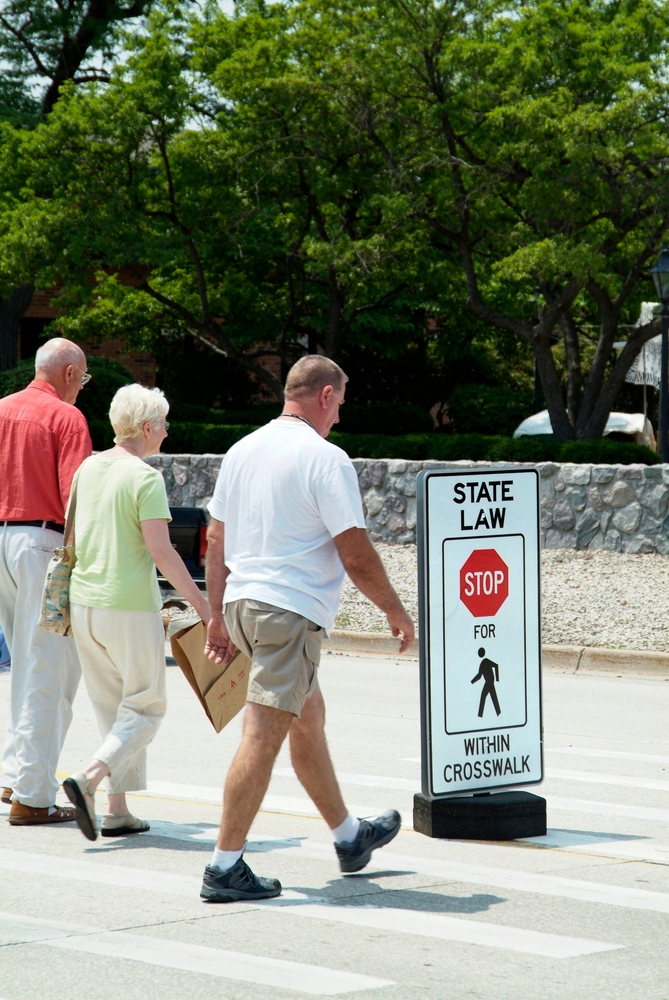Whether you’re a driver navigating busy intersections or a pedestrian crossing Colorado streets, knowing your rights and responsibilities under state law can mean the difference between safety and tragedy. In 2023 alone, there were 136 pedestrian fatalities in Colorado.
These laws exist to keep everyone safe, but they only work when both drivers and pedestrians understand and follow them. This guide breaks down Colorado’s pedestrian laws in clear, straightforward terms so you can confidently navigate the state’s roadways while protecting yourself and others.

Do Pedestrians Have the Right-of-Way in Colorado?
Yes, in Colorado, pedestrians have the right of way at intersections and both marked and unmarked crosswalks. Drivers must yield to pedestrians and allow them to cross safely. However, pedestrians must not step into the path of an oncoming vehicle when it is so close that it is impossible for the driver to stop.
Pedestrians Must Follow Traffic Control Devices
According to § 42-4-801, pedestrians must obey traffic control devices that are specifically directed toward them, unless otherwise directed by law enforcement.
Colorado Pedestrian Signal Meanings
- “Walk” (Steady Signal): When you see a steady “Walk” indication, you may proceed across the roadway in the direction indicated. Drivers must yield the right-of-way to you during this time.
- “Don’t Walk” (Steady Signal): A steady “Don’t Walk” signal means you cannot enter the roadway. Wait for the next “Walk” signal before beginning to cross.
- “Don’t Walk” (Flashing Signal): If you see a flashing “Don’t Walk” signal, do not start crossing. However, if you’re already in the middle of crossing when it begins flashing, continue to the sidewalk or safety island. Drivers must yield to pedestrians completing their crossing.
Pedestrians’ Right-of-Way in Crosswalks
Drivers must yield to pedestrians in crosswalks when signals are not present or not functioning, according to § 42-4-802. Pedestrians may not suddenly step off the curb into the path of a vehicle.
Drivers are prohibited from passing a vehicle stopped at a crosswalk, and pedestrian signal indications govern crossing behavior. Violations are Class A traffic infractions.
Crossing at Other Than Crosswalks
§ 42-4-803 says that pedestrians crossing outside a marked or unmarked crosswalk must yield to vehicles. Between signalized intersections, pedestrians may only cross in marked crosswalks, and diagonal crossing requires official authorization. Violations are Class B traffic infractions.
Pedestrians Walking or Traveling in a Wheelchair on Highways
Pedestrians using highways where sidewalks are not available must walk as close to the outside edge or on the left side facing traffic according to § 42-4-805. This includes wheelchair users and also prohibits obstructive behavior, such as dangerously soliciting rides.
Driving Through Safety Zone Prohibited
Vehicles may not be driven through marked pedestrian safety zones, according to § 42-4-806.
Drivers to Exercise Due Care
§ 42-4-807 states that drivers must take due care to avoid colliding with pedestrians, including using the horn when necessary, and exercising extra caution around children and incapacitated individuals.
Yielding to Individuals with Disabilities
Drivers and pedestrians must yield the right-of-way to individuals with disabilities under specified conditions, ensuring safe roadway access, according to § 42-4-808.
Read More: What is the Average Pedestrian Accident Settlement Amount?

Safety Tips for Colorado Pedestrians and Drivers
Pedestrian Tips
- At intersections with traffic lights, always follow the signals. Press the crosswalk button, wait for the WALK signal, and cross carefully.
- Keep your phone away and stay alert.
- If the DON’T WALK signal is flashing, don’t start crossing. If you’re already in the street, finish crossing quickly and safely.
- A steady DON’T WALK signal means wait for the next WALK signal before crossing. Even with the WALK signal or green light, check for oncoming traffic and make eye contact with drivers to ensure they see you.
- At night, wear light-colored clothing and stay in well-lit areas.
Driver Tips
- Stop before the crosswalk, not in it.
- When the light turns green, proceed slowly and check your surroundings. Make eye contact with pedestrians to ensure their safety.
- Signal your turns clearly.
- At night, reduce speed and use your headlights.
- Put your phone away. Always yield to pedestrians and slow down, especially in busy areas.
Colorado’s Pedestrian Safety Campaign: Left Behind
The Colorado Department of Transportation’s “Left Behind” campaign directly confronts the tragic rise in pedestrian deaths. Nationally, 5,000 pedestrians die and 70,000 are injured annually, with children and the elderly at extreme risk.
Protect the Rights of Colorado Pedestrians
Colorado pedestrian right-of-way laws exist to save lives, but they only succeed when everyone understands and follows them. Unfortunately, many walkers, runners, and bikers are hit by drivers and suffer catastrophic injuries.
If you’re the victim of a pedestrian accident, contact our attorneys at DM Injury Law. Our attorneys and expert support staff will handle the insurance company and seek the compensation you need to move forward.
Contact us today to schedule a free consultation.
If you travel across the Midwest, we have other pedestrian right-of-way law guides for you to review:
If you’re looking for more safety tips, sign up for our monthly newsletter.




